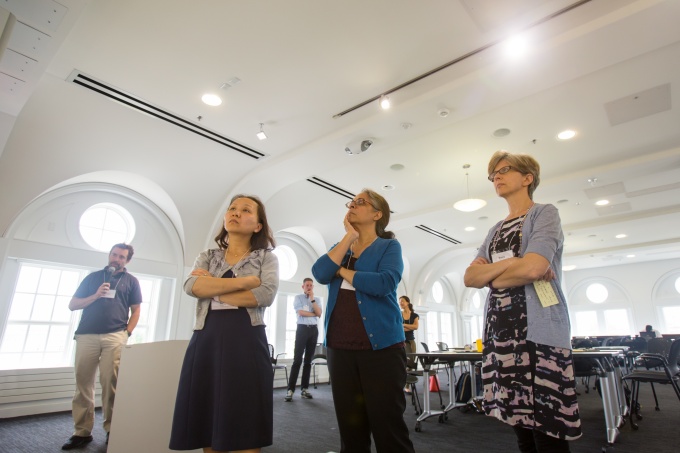Illuminating the Exposome

Faculty members Janet Yang (communications), Sharmistha Baghchi-Sen (geography), and Kasia Kordas (epidemiology) at the Air Quality Ideas Lab
The leading environmental health hazard is air pollution. While this and other toxins in food and the environment have proven especially threatening in the first 1,000 days of life, little is known about the cumulative, life-course effects on physical and mental health. To illuminate the “exposome” – the totality of cultural, nutritional, and environmental exposures – we investigate intersections between biomarkers and geo-markers, daily routines and family histories, prenatal care and life-long habits.
What is Special About Early Life?
Children are very vulnerable during their first 1,000 days of life. In the womb, embryonic or fetal tissue is highly sensitive and organs are developing. After birth, a young child goes through rapid growth and development with changes in organ system functioning, metabolic capacities, physical size, and immature defense systems. It is during this time period that they are particularly vulnerable to environmental exposure.
What is the Exposome?
The exposome is the sum exposure, the totality of environmental exposures from conception onwards. The exposome includes exposure to air pollution, water pollution, metal pollution, the social environment, life style factors, and others. The totality of these exposures at a young age can affect fetus growth, birth outcomes, child development and child health.
For example, 3 billion people use solid fuels everyday, exposing women and young children to high levels of indoor air pollution. The World Health Organization estimates that people most likely to breathe poor-quality air live in low- and middle-income countries, where they may also experience hunger, malnutrition, infectious disease, conflict, and natural disasters. In many of these areas, the problem of air pollution is intractable, even as consequences for young children and other vulnerable groups are acknowledged.
Poor air quality has detrimental effects on fetal and postnatal growth and development. Despite decades of efforts to improve air quality, pregnant women and young children around the world still breathe polluted air, initiating lifelong health problems and causing early death. For many, inadequate air quality is inescapable, with exposure occurring consistently during everyday indoor and outdoor tasks.

Meet Gauri Desai: Recent Doctoral Graduate and CGHE Alumna who recently won the Saxon Graham Dissertation Award
Our Working Solutions

Our Team
Co-Lead Early Life Exposome Team; Assistant Professor
Epidemiology and Environmental Health and Community for Global Health Equity
Email: lesmith6@buffalo.edu
Project Lead, E-waste Recycling; Assistant Professor
Department of Civil, Structural and Environmental Engineering
Current interests: B-vitamins and arsenic methylation; effects of low-level arsenic exposure on child cognition and learning.
Email: gauriabh@buffalo.edu
Co-lead, Food Equity Team; Assistant Professor
Urban and Regional Planning and Community for Global Health Equity
Email: frimpon@buffalo.edu
Project Lead, Multiscalar Analysis of Fuel Transitions; Associate Professor
Political Science
Project Lead, Air Pollution Exposure During Pregnancy; Associate Professor; Director, Office of Global Health Initiatives
Department of Epidemiology and Environmental Health

Seth Frndak
PhD Candidate
Epidemiology and Environmental Health and Community for Global Health
Email: sethfrnd@buffalo.edu

Marissa Kawyn
UB Alumna; Former Graduate Assistant
Epidemiology and Environmental Health and Community for Global Health
Email: mnkawyn@buffalo.edu
Our work is done in collaboration with many talented community partners. We list these partners on the affiliated project pages.































